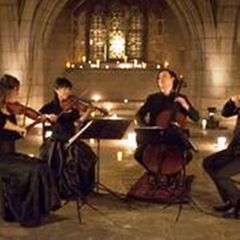|
Back
Sepulchral Sounds New York
The Crypt, Church of the Intercession
02/01/2018 -
Ludwig van Beethoven: String Quartet in A Minor, Opus 132
Attacca Quartet: Amy Schroeder, Keiko Tokunaga (Violins), Nathan Schram (Viola), Andrew Yee (Cello)

The Attacca Quartet in the crypt (© Tristan Cook)
“The way upward and download is one and the same.”
Heraclitus (500 B.C.)
“Neither movement from nor towards,
Neither ascent nor decline. Except for the point, the still point,
There would be no dance, and there is only the dance.”
T.S. Eliot (1888-1965), from Four Quartets
Ludwig van Beethoven’s penultimate string quartet, written in physical and probably spiritual pain, has so many external revelations that its performance in the underground crypt of an uptown New York church seems instinctual. The Heraclitus quote above–part of T.S. Eliot’s epigraph for Four Quartets– could also relate to Beethoven’s themes in the 15th Quartet. Eliot himself was listening to Opus 132 when composing the Four Quartets and mentioned it as an example how Beethoven “strove to get beyond music.”
Never mind that Beethoven would have snorted at such an idea. Closer, though to last night’s performance is that Aldous Huxley in his mixed-up salmagundi, Point Counterpoint, used Opus 132 as obsessive background music for a character soon to commit suicide.
(At this point, Ludwig would have raised his shaggy eyebrows and roared with laughter.)
But now onto the crypt. Beethoven himself was studying medieval church music at that time (as almost unknown Palestrina), and no less an expert that Charles Rosen conceived the slow movement as a variation of a Gregorian Chant. As if these archaic references aren’t enough, the Church of the Intercession, high up in Washington Heights, has a century-old building which was modeled on an ersatz 600-year-old Tudor model.
Finally, the creator, producer and–let’s give credit where it’s due–auteur of the “The Crypt Sessions”, Andrew Ousley, has a radical method of choosing his monthly concerts here: “I simply select what I think will be appropriate.” (He also donates all proceeds of the concerts to the church itself, but is too modest to mention that.)
This leaves a lot of leverage. Yet by employing the fervent, whip-sharp young Attacca Quartet to perform this work–a piece which transcends age–Mr. Ousley was a virtual Solon. Of course the A Minor Quartet is wondrous to hear in any concert hall. But down in the Tudor-revival church crypt, with its tiny audience religiously silent, even the acerbic Beethoven would have perhaps nodded that heavy old head. He would never approve, but his inner mind might sanction such heterodoxy.
The sacred surroundings also gave us leave to think about music which we had known and studied, to actually listen as philosophers. From the first sustained cello motive and four-measure fugue, we could hear Beethoven breathing heavily, perhaps waiting for the Allegro out of which he would generate that cryptic first movement. And last night, with that smart, restrained violence of the Attacca Quartet, the quote from Heraclitus came rushing through. These were no Classical balances, these were no Romantic developments. Beginnings and endings were lost, twirled up in their own helixes, directions (Heraclitus’s “up and down”) almost irrelevant.
It takes awhile to get accustomed to the dry acoustics in the Crypt. The Attacca Quartet plays on a tight-wire, but they are never reckless, and that was fortunate, since any error would be instantly caught in this underground chamber. On the other hand, one does not hear the “conversation among friends” so much as the individual players, each voice different, each instrument giving a monologue in the company of friends.
For the first movement, this was fortunate, since nothing written by Beethoven was cut-and-dry. For the second-movement minuet, we had the T.S. Eliot contradictory feeling about the dance. This and the fourth movement hark unavoidably to Mahler as well, the folkish simplicity hiding a more ghostly inner voice. The four instruments were still unique, but the auditory balance of the instruments was technically perfect. True, physically, the emotions of cellist Andrew Lee became a cynosure, but hardly distracting from the rest.
The center of the quartet is of course the slow third movement, to which Beethoven appended “thanks for healing.” (The healing was probably his chronic hemorrhoids, proving that even Our Leader’s “s__t h__e” can be productive.) Like the Church of the Intercession, these were chorales from a different era, played (as Beethoven accented in words) in a Lydian mode, transporting us from the early 19th Century Age of Reason to an archaic age of Faith in spite of itself.
From the weird Mahler-esque march to a recitative to the attack on the finale, we had a Beethoven which transcends performance. The Attacca played it up to its fever pitch, Mr. Lee almost shrieking out on the highest cello register. And then...well, we know that Beethoven was studying Bach and Palestrina. But like the poets of the 1960’s going into Zen, Beethoven was also studying the trendy Indian Vedas. What influence it had we may never know. But the solace brought a spiritualism which exemplified Huxley’s Perennial Philosophy.
One must confess that listening to the music could not be separated from the medieval atmosphere. Purity, though, wasn’t the point. The experience of the crypt, of the cryptic music and the arousing joy of the Attacca Quartet became Eliot’s credo after his own poetic descent to his own sepulcher: “After the kingfisher’s wing/Has answered light to light, and is silent/The light is still
At the still point of the turning world.”
CODA: The next two concerts of the Crypt Session are on March 14 and 15. More information here.
Harry Rolnick
|